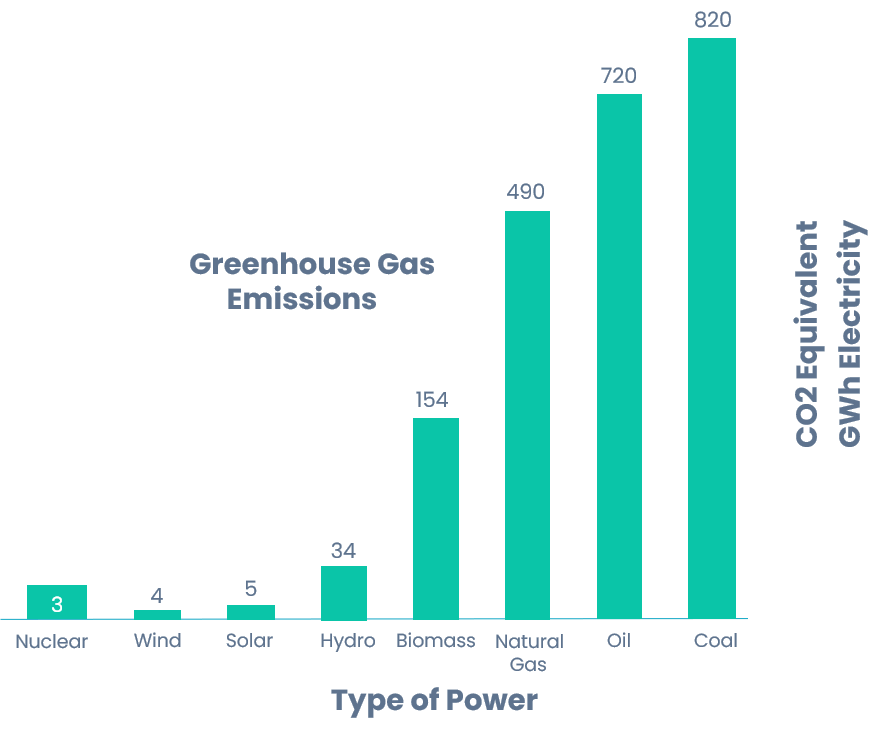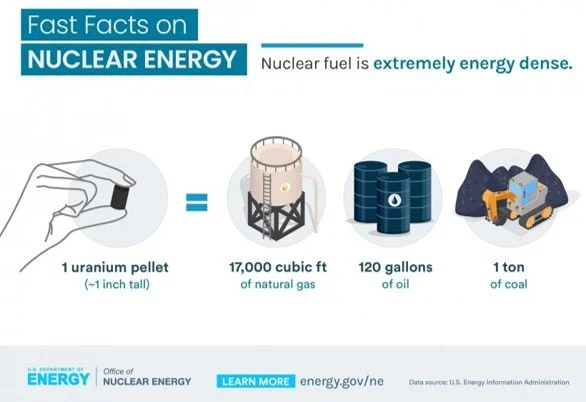WHY NUCLEAR?
Increasing acceptance of nuclear as a positive ESG (Environmental, Social, and Corporate Governance) investment
In addition to providing base-load, CO2 emissions-free, low-cost energy, nuclear provides unmatched electricity generation in Mw / square kilometre
Largest offshore windfarm in world (Walney in Irish Sea) generates < 2 Mw / square kilometre
The largest nuclear power plant in world (Kashiwazaki-Kariwa in Japan) generates 1,955 Mw / square kilometre
HOW CLEAN IS NUCLEAR?
Nuclear is a zero-emission clean energy source.
It generates power through fission, which is the process of splitting uranium atoms to produce energy. The heat released by fission is used to create steam that spins a turbine to generate electricity without the harmful byproducts emitted by fossil fuels.
According to the Nuclear Energy Institute (NEI), the United States avoided more than 476 million metric tons of carbon dioxide emissions in 2019. That’s the equivalent of removing 100 million cars from the road and more than all other clean energy sources combined.
It also keeps the air clean by removing thousands of tons of harmful air pollutants each year that contribute to acid rain, smog, lung cancer and cardiovascular disease.
HOW SAFE IS NUCLEAR?
Uranium has the lowest mortality rate per terawatt hour of energy produced, when compared to other energy sources.
Nuclear is among the lowest-carbon forms of energy we know
GLOBAL URANIUM DEMAND
USA
The largest consumer of uranium with nuclear generating 20% of its electricity through 96 operating reactors. 2019 US production fell to <1% of domestic demand with Russia, Kazakhstan, Uzbekistan supplying ~40% of US requirements
CHINA
Currently 49 reactors operating with 14 under construction and many more reactors planned/ordered and proposed; tripling capacity by 2030 China’s recent 5 Year Plan included 70 GWe nuclear target by 2025 up from 48 GWe currently - commitment to be carbon neutral by 2060 CGN Mining of China and CEF Holdings (Li Ka-shing and CIBC) have made major investments into Canadian uranium companies
JAPAN
10 reactors have restarted operations up from 3 in 2016 6 more reactors have been approved for restart and 10 more have applied for restart
Nuclear energy is expected to account for over 20% of Japan’s power by 2030 (about 30 reactors)
RUSSIA
Currently 38 reactors operating with 4 under construction and 46 planned Export reactors: constructing 36 units abroad and will fuel them
Control significant amount of global mine supply as well as enrichment capacity
INDIA
Currently 22 reactors operating with 7 under construction and 42 reactors planned and proposed Canada and India announced $350 million deal in 2015 for Cameco Corp. to supply 3,220 tonnes U3O8 to power Indian reactors over 5 years
India plans for 21 new nuclear reactors by 2031
Global electricity demand is expected to increase by 49% from 2019 - 2040
Source: IEA World Energy Outlook 2020 Stated Policies. Methodology for estimates is outlined in the International Atomic Energy Agency report “Analysis of Uranium Supply to 2050,” available at https://www-pub.iaea.org/MTCD/Publications/PDF/Pub1104_scr.pdf.
IS URANIUM ENTERING A BULL MARKET?
Source: TradeTech LLC. Data as of 10/31/2021.
MINIMAL WASTE
Nuclear fuel is extremely dense. It’s about 1 million times greater than that of other traditional energy sources and because of this, the amount of used nuclear fuel is not as big as you might think.
All of the used nuclear fuel produced by the U.S. nuclear energy industry over the last 60 years could fit on a football field at a depth of less than 10 yards!
That waste can also be reprocessed and recycled, although the United States does not currently do this. However, some advanced reactors designs being developed could operate on used fuel.
















